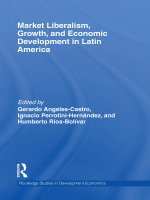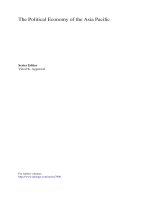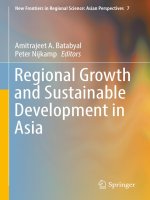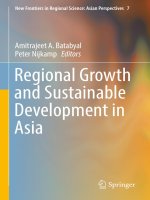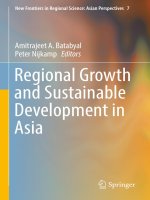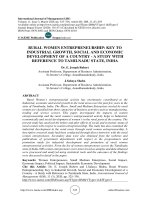Economic growth and economic development 156
Bạn đang xem bản rút gọn của tài liệu. Xem và tải ngay bản đầy đủ của tài liệu tại đây (98.87 KB, 1 trang )
Introduction to Modern Economic Growth
and the residuals can be interpreted as estimates of technology differences. Unfortunately, this approach is not particularly attractive, since the potential correlation
between log Aj and log Kj or log Hj implies that the estimates of α need not be unbiased even though we impose the constant returns to scale assumption. Moreover,
if we do not impose the assumption that these coefficients sum to one and test this
restriction, it will be rejected. Thus, this regression approach runs into the same
difficulties as the Mankiw, Romer and Weil approach discussed previously.
What this discussion highlights is that, even if we are willing to presume that
we know the functional form of the aggregate production function, it is difficult to
directly estimate productivity differences. So how can we improve over this naăve
approach? The answer involves making more use of economic theory. Estimating an
equation of the form (3.28) does not make use of the fact that we are looking at the
equilibrium of an economic system. A more sophisticated approach would use more
of the restrictions imposed by equilibrium behavior (and to bring additional relevant
data). We next illustrate this using a specific attempt based on international trade.
The reader who is not familiar with trade theory may want to skip this subsection.
3.6.2. Learning from International Trade*. We will discuss models of growth
in trade in Chapter 20. Even without a detailed discussion of international trade
theory, we can use data from international trade flows and some simple principles
of international trade theory to obtain another way of estimating productivity differences across countries.
Let us follow an important paper by Trefler (1993), which uses an augmented
version of the standard Heckscher-Ohlin approach to international trade.
The
Heckscher-Ohlin approach assumes that countries differ according to their factor
proportions (e.g., some countries have much more physical capital relative to their
labor supply than others). In a closed economy, this will lead to differences in relative factor costs and differences in the relative prices of products using these factors
in different intensities. International trade results as a way of taking advantage of
these relative price differences. The most extreme form of the theory assumes no
cost of shipping goods and no policy impediments to trade, so that international
trade can happen costlessly between countries.
142
